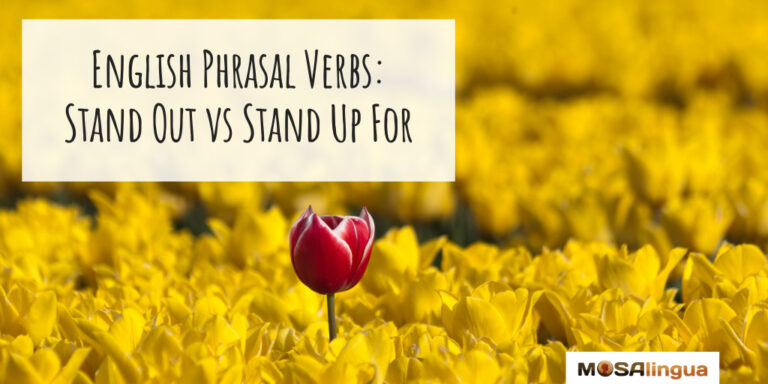If you haven’t ever tried using TV to improve your language skills, it’s about time you did! It can be both effective and entertaining (which is just as important)! To prove it, we recommend that you check out our series on English phrasal verbs. We use clips from our favorite American TV shows to provide context and examples for new vocabulary. In this short lesson, learn about phrasal verbs with “stand” and how to use them. Our English instructor Lizzie Jane has put together a video to help you remember the meaning of the phrases “stand out” and “stand up for.” Grab some popcorn and let’s get started! 🍿

English Phrasal Verbs with “Stand”
In this lesson, we’ll teach you some of the common phrasal verbs that use the root verb “to stand”:
- to stand around
- to stand between
- to stand down
- to stand for
- to stand in for
- to stand out
- to stand up for
- to stand up to
If you’ve been following along with our English phrasal verbs series, you probably already know what a phrasal verb is.
What is a phrasal verb?
If this is your first time, welcome! (Or if you just need a little refresher, that’s okay too!)
Here’s a quick definition to start: a phrasal verb is an expression that’s made up of a verb paired with another word, usually a preposition, that changes its meaning. As a result, it becomes an idiomatic phrase.
Phrasal verbs are super useful, and they’re very common in both spoken and written English. Instead of needing to learn a long list of words that are completely different from one another, you can build new expressions by adding words you already know together. And just like magic, they take on a new meaning!
However, it can sometimes be tricky to remember phrasal verbs, because they are pretty similar to one another!
We can help with that—the MosaLingua app uses the spaced repetition system to help you commit new vocabulary to your long-term memory.
And our instructors know firsthand the challenges that come with learning new vocabulary, so we have all kinds of tips and advice for memorizing new information quickly and effectively.
But like most things, practice and exposure are the most important tools. The activity below should be useful for that!
First, have a look at the table below for an introduction to different English phrasal verbs using “stand.” We’ve included definitions and example sentences to help you get off on the right foot.
Then, check out Lizzie’s video. For this activity, she picked a clip from The Simpsons, one of our favorite shows for illustrating everyday English conversations.
| VERB | DEFINITION | EXAMPLE |
|---|---|---|
| to stand | 1. to support oneself on the feet in an erect position 2. to be a specified height when fully erect 3. to rise to an erect position | 1. They told me to stand against the wall. 2. The average male giraffe stands 16 feet tall. 3. Please stand (up) when your name is called. |
| to stand around | to stand without doing anything | People were standing around waiting to get inside the theater. |
| to stand between | to be positioned between two things (often used figuratively) | 1. A row of trees stands between the two houses. 2. A single point stands between her and the title. If she makes it, she wins. |
| to stand down | to withdraw from a position of leadership | He's decided to stand down after 15 years as managing director. |
| to stand for | 1. to put up with 2. to be a symbol for | 1. I wouldn't stand for that sort of behavior, if I were you. 2. GMT stands for Greenwich Mean Time. |
| to stand in for | to take the place of a person who cannot perform their duty | The understudy stood in for the actor when he was sick. |
| to stand out | to be prominent or conspicuous | We had lots of good applicants for the job, but one stood out from the rest. |
| to stand up for [something/someone] | to defend against attack or criticism | With five older brothers, I soon learned to stand up for myself. |
| to stand up to | to face boldly | He wasn't afraid to stand up to bullies. |
Watch: Phrasal Verbs with “Stand” In Context – Stand Out vs. Stand Up For
Our English instructor Lizzie created a short video exercise to help you learn how to use these phrasal verbs in context. She’ll teach you the phrasal verbs “stand out” and “stand up for” and their meanings. Afterward, she’ll quiz you on what you remember!
You can watch it right here or on our YouTube channel. The video is in English, but you can still watch with Spanish, French, German, Italian, or Portuguese subtitles. Click the “Settings” gear at the bottom right to turn on subtitles or change the playback speed.
Subscribe to our YouTube channel to learn more phrasal verbs with clips from TV shows
Phrasal Verbs Activity: Video Transcript
Good news – you can still do Lizzie’s exercise, even if you can’t watch the video!
First, read the transcript from the scene below. Then fill in the blank with the correct phrasal verb. Take your best guess, then highlight the black lines below with your cursor to reveal the answer! Good luck! (And don’t forget to bookmark this article or share it on your social media so you can come back and watch the video later!)
Context: In this clip, Homer and his daughter Lisa are arguing about a backyard barbecue. Homer wants Lisa to apologize, but she will not. She believes what she did was right.
Transcript:
Homer: “Lisa, you ruined my barbecue! I demand you apologize this second!”
Lisa: “I’m never ever apologizing because I was ______ a just cause!”
Hint: Still not sure what the right answer is? We’ll give you a hint! The word in the blank is either STANDING OUT or STANDING UP FOR. If you need to, you can always look back at the meaning of “stand out” and “stand up for” in the table above.
Answer
STAND UP FOR; Lisa said that she was STANDING UP FOR a just cause. Remember, the expression “to stand up for” means to defend someone/something against attack or criticism.
*If you’re reading this on a mobile phone, or if highlighting the text doesn’t show the answer, scroll down to the bottom of the article and flip your device upside down to see if you guessed correctly!
Next Steps…
And finally, if you enjoyed the article and activity, don’t forget to subscribe to our YouTube channel and turn on your notifications. That way, you’ll know when the next video in our phrasal verbs series comes out! In the meantime, here are some other articles you might enjoy:
- Call off vs Call out | Learn English With TV Series [VIDEO]
- English Phrasal Verbs with Go | Go Out VS Over [VIDEO]
- 15 Things You Didn’t Know about the English Language
- Make or Do | English Grammar Hacks
*·ɯsᴉɔᴉʇᴉɹɔ
ɹo ʞɔɐʇʇɐ ʇsuᴉɐɓɐ ɓuᴉɥʇǝɯos/ǝuoǝɯos puǝɟǝp oʇ oʇ suɐǝɯ ˌˌɹoɟ dn puɐʇs oʇˌˌ uoᴉssǝɹdxǝ ǝɥʇ ʻɹǝqɯǝɯǝꓤ ·ǝsnɐɔ ʇsnꓩ ɐ ꓤOꓞ ꓒꓵ ꓨNIꓷNⱯꓕS sɐʍ ǝɥs ʇɐɥʇ pᴉɐs ɐsᴉꓶ ;ꓤOꓞ ꓒꓵ ꓷNⱯꓕS




Comments